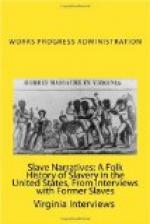Education
“In 1866, everybody that was less than sixteen years old in South Carolina had to go to school. The little fellows that had been slaves had to go to school, and they got some education. You will hardly find an old man from South Carolina around my age who can’t read and write. There was one hundred sixty pupils in my school. All boys. I never went to a mixed school—a school where they had boys and girls both.
“The first school I attended was in Ebenezer. I went to high school in Macklenburg. Miss Sallie Good and Miss Mattie Train, Elias Hill, and David G. Wallace—all of these were my teachers. They were all white except Elias Hill. He was the only colored teacher in that section of the country—at that time.
“When I finished high school, I went to Biddle University. Biddle was a boys’ school. It was in Charlotte, North Carolina. They had a girls’ school in Concord, North Carolina. Biddle is still running, but it has another name. Dr. Mattoon was president of Biddle then and Dr. Darling was president of the girls’ school.
Murders
“The first murder ever I saw was Violet Harris killed Warren Fewell. It come over a family quarrel some way. They fell out over something. She was not related to him. It was done right at the fence at her gate. She cut him with a butcher knife—stuck him just once right through the heart. That is the first murder I ever saw. They were both colored. The War was just winding up. It happened in Ebenezer. I don’t recall that they punished her.
“I have seen a white man killed by a white man, and I have seen a colored man killed by a colored man; but I have never seen a colored man killed by a white man or a white man killed by a colored man. I have seen them after they were killed, but I never seen the killing. I have seen both races killing their own, but I have never seen them killing across the races.
“About fifty years ago, I saw a young man come in the church and kill another one. Just come in and shot him. That is been fifty years ago—back in 1881 in Ebenezer.
“Rock Hill, South Carolina, from 1876 to a while later, bore the name ‘Bloody Town.’ They killed a man there every Saturday night in the year—fifty-two times a year they killed a man. They had to send for the Federal troops to bring them down. They didn’t just kill colored people. They killed anybody—about anything.”
Interviewer: Mrs. Bernice Bowden
Person interviewed: Frances Smith
2224
Havis Street, Pine Bluff, Arkansas
Age: 77
“I specs I was born in slavery times. I remember seein’ the Yankees. That was in Mississippi. I’m seventy-seven—that’s my age.
“Spencer Bailey was old master. Just remember the name was ’bout the biggest thing I knowed about. I seen him all right but I didn’t know much about him ’cept his name.




